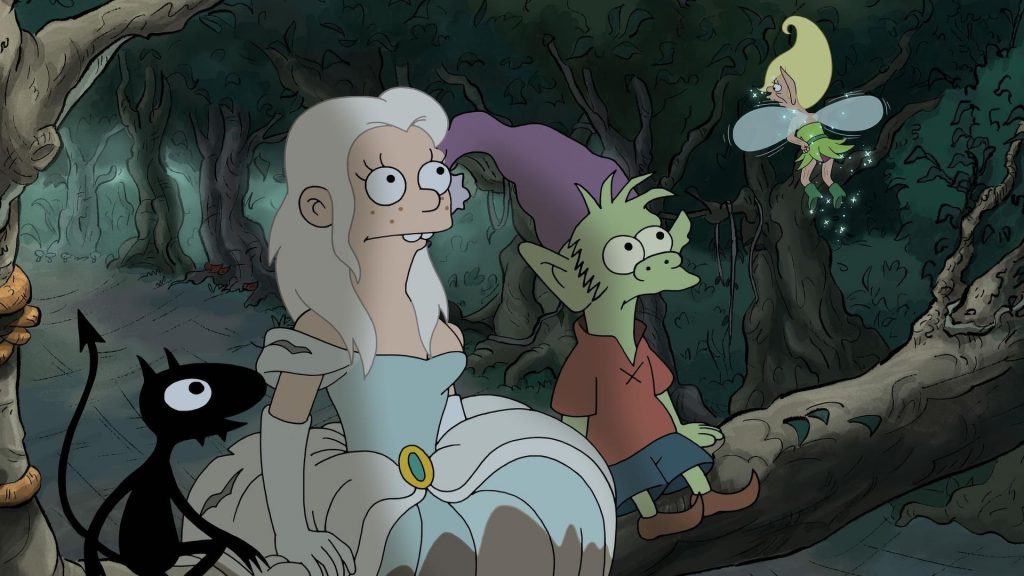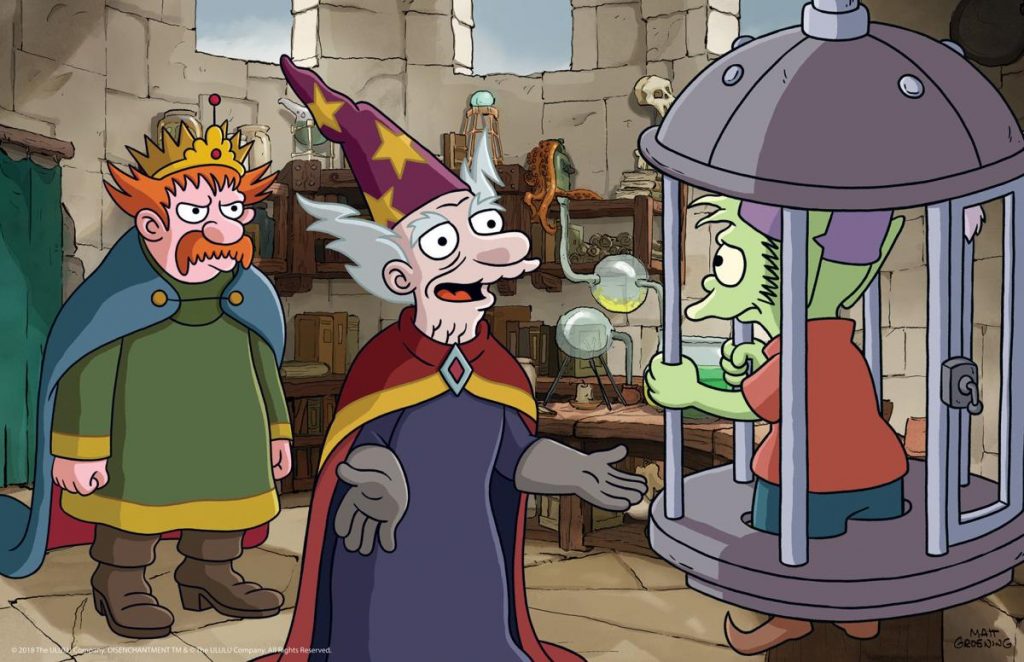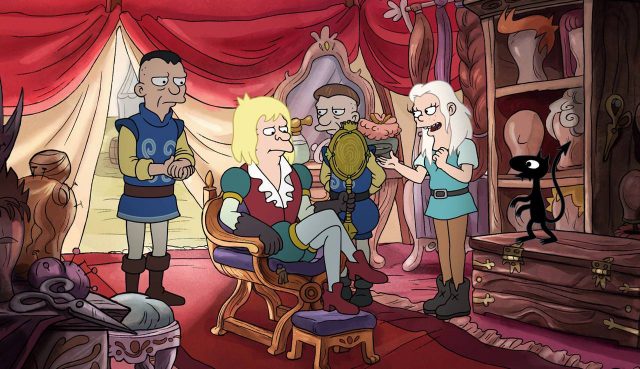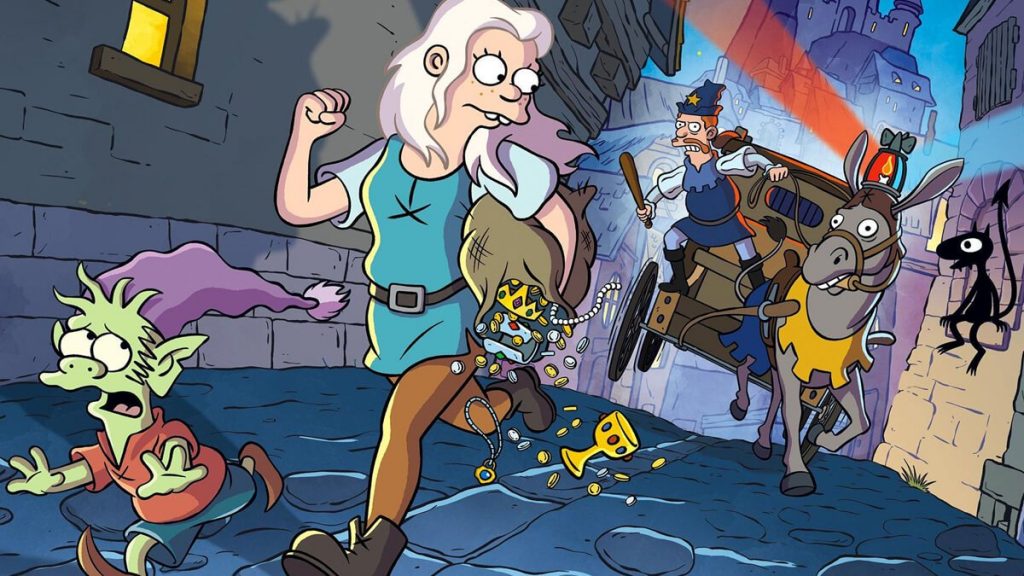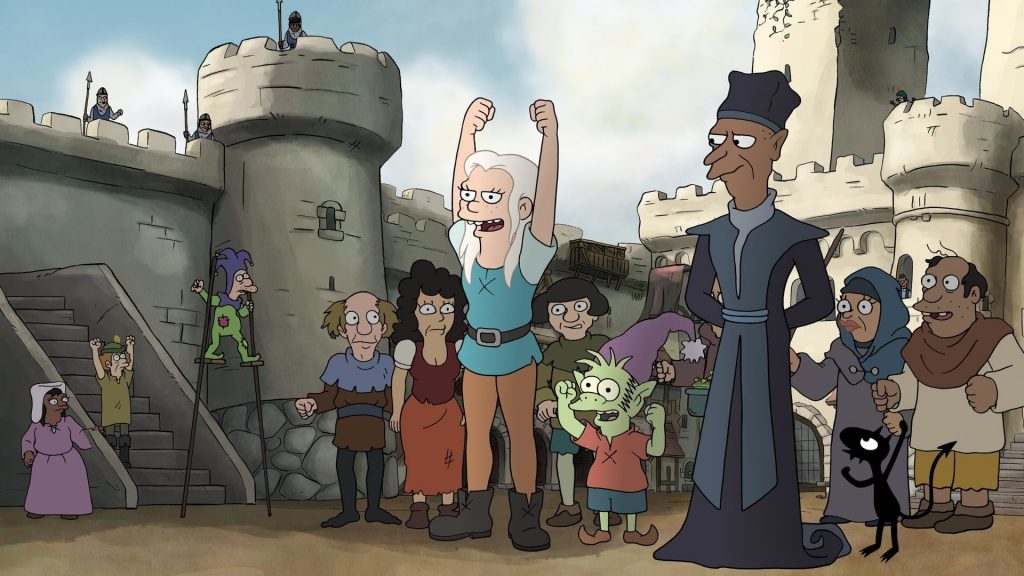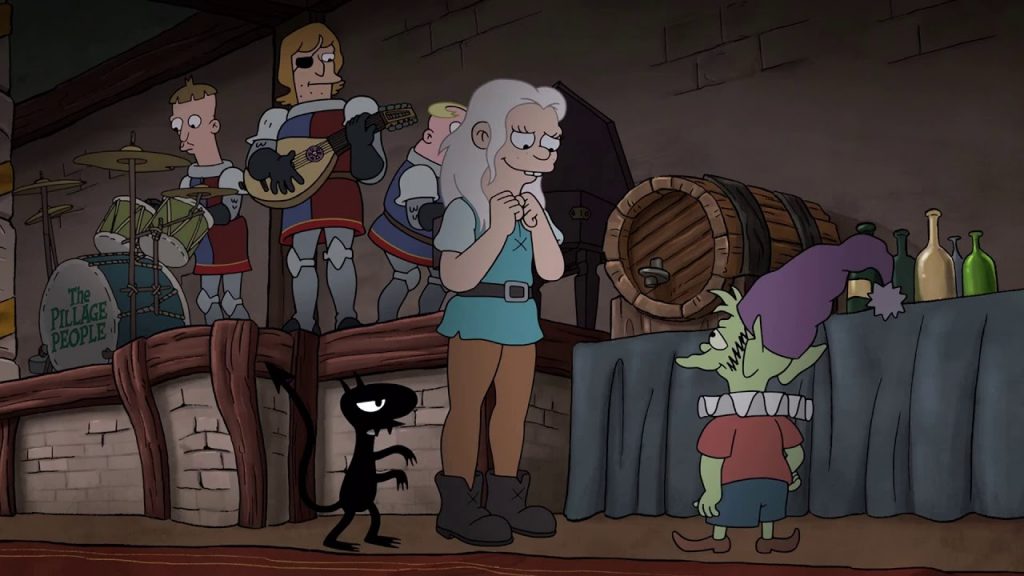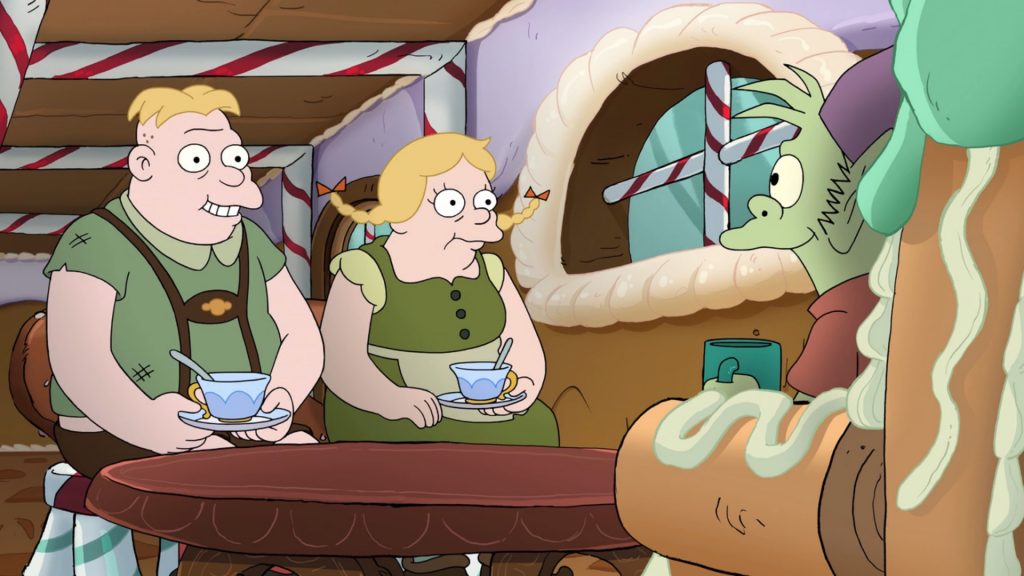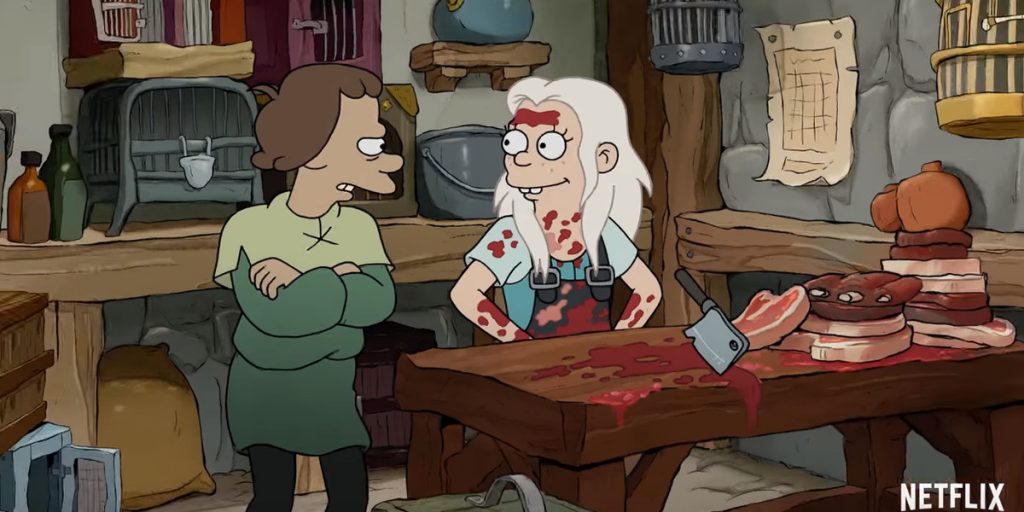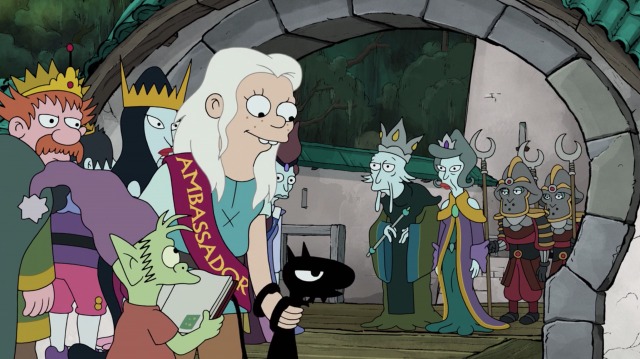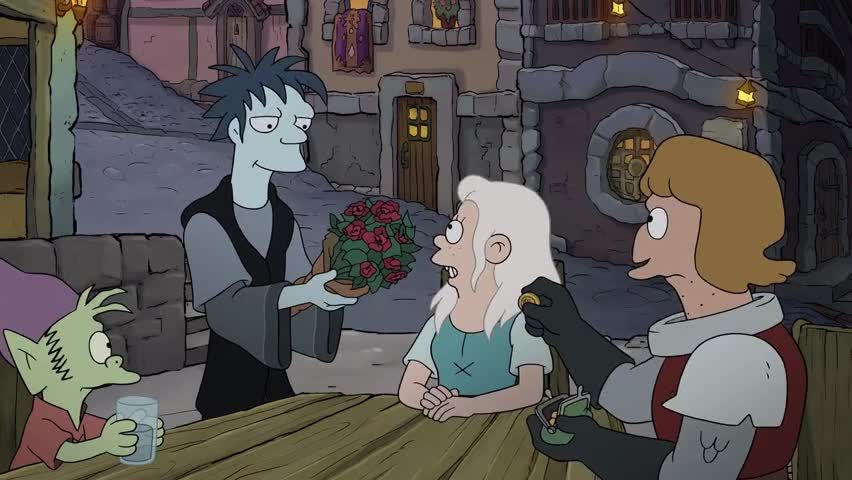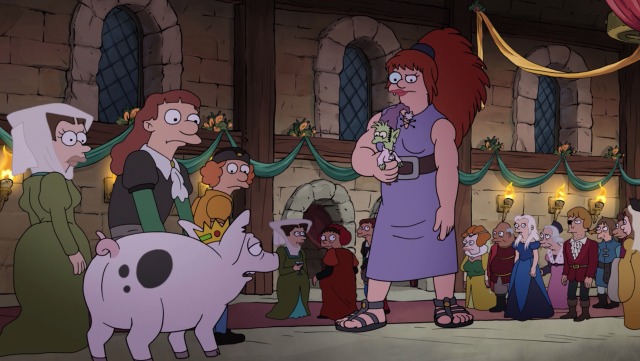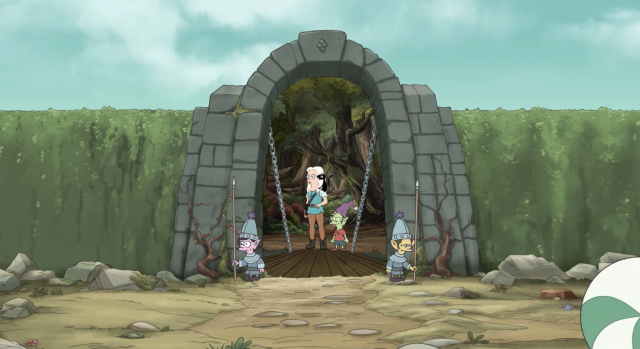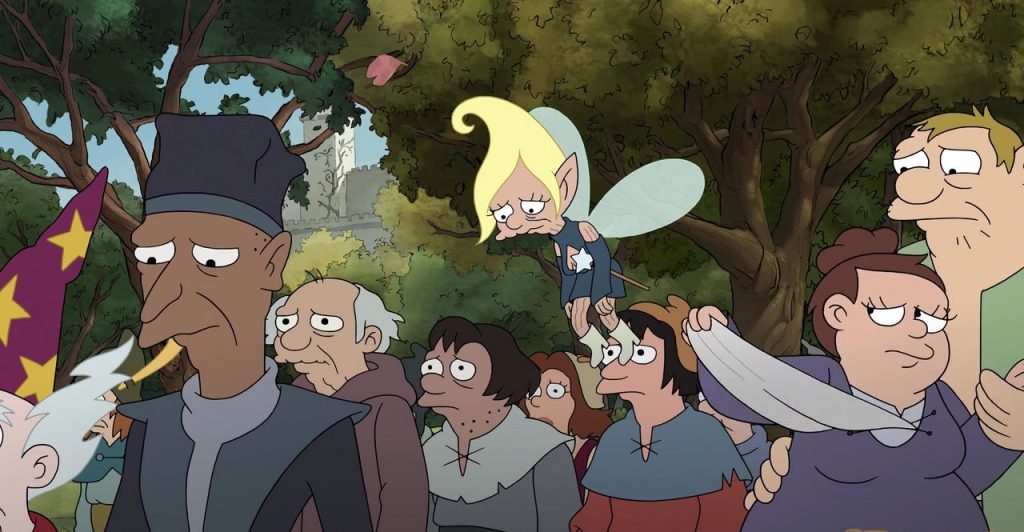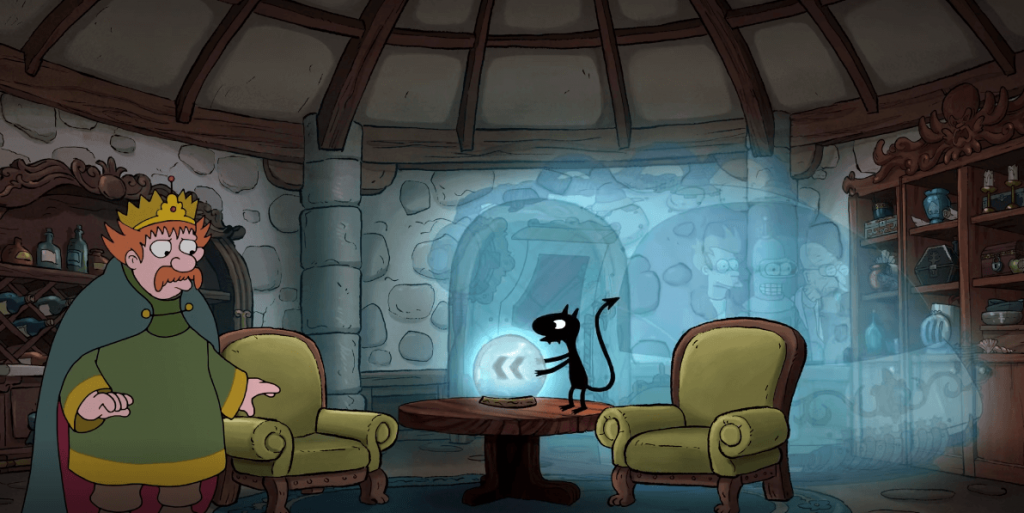The Following is a review of the series Disenchantment, created by Matt Groening. Now available streaming on Netflix. Warning, there will be spoilers but with forward notice before reading.
As a screenwriter, one of the things that bothers me about pilots is how much needs to be established. The opening scene needs to convey who this protagonist is. And by the end of it, where is this person going. Though it can often feel inauthentic, it does tell the audience: “Hey, this is me!” As we tag along the ride of our main character.
Atop that, you must account for cinematography – the opening pilot, setting the bar for how technical or ridiculous the series can be. Often, pilots go over budget because we’re not sure if the series will move further than the first episode. For better or worse, your pilot needs to sell. It needs to hook the audience with the promise of more.
But it also must establish the ground rules of the universe. Is the flying machine science or magic? Is the war between Giants and Faeries drama or comedy? Do we laugh or cry or cringe at someone’s misfortune? This all needs establishing while still telling a mini story. So TV pilots are rather frustrating. But I say with confidence, that this show does a pretty decent job with the pilot – though it’s not perfect.
Animation is tricky because there are fewer restrictions. So there is a lot in this show that I need to cover. My coverage of episode one will be more of a recap, as I need to discuss elements of the pilot that set up the series. For the other episodes, I’ll write a spoiler-free review, with a segment titled spoilers that may contain callbacks or bits of dicey information.
Episode 1: A Princess, a Demon and an Elf Walk into a Bar:
We open on a high tower in the castle. In the princess’ room we expect to find her in bed, but instead, meet a guard –tied up and regretting his assigned duty to look out for her.
This is somewhat of a common occurrence it seems.
We meet the actual princess in a bar. She’s drinking and gambling away for the hell of it. Shortly after, she gets into a fight over poker winnings – in which she holds her own. Some clever antics and maneuvering, she escapes the bar fiasco with a, “See you guys tomorrow!” line.
We the audience now know this is a common occurrence.
She is asked to return home by Odval, the Prime Minister of dreamland, as she’s then to be wed the following day. She goes willingly.
Now, within the first three minutes of the pilot we establish some major things:
- Who princess Beanie is: a troublemaker who can hold her own that’s being forced to wed.
- We get a panoramic of the Kingdom of Dreamland as she’s escorted out – the layout and design in detail: the castle, the statue of the formerly heroic king Zog, the princess’ tower – whose design is a lot more complicated than the series leads on initially (spoilers later). We also see a grand waterfall tipping over the edge of a cliff – where a castle with this basin serving as a sort of witty execution device (in homage to the Eeyrie in Game of Thrones) but also
- This is all sort of critical to the story we’re looking to tell here. And a lot of what we see will be used later on – if not now, then definitely by season 2.
- We get a LOT of visual gags. This sets up the expected comedy of this universe, like Futurama before it, you have to look for the Easter eggs. We also meet the sorts of people we’ll be dealing with on the streets of Dreamland.
And that’s just the first three minutes of the pilot. Which seems simple but is quite technical. This is the kind of thing I praise about the series. Unlike traditionally animated comedies, where it’s all about simple consumption and one-off gags, this show is very layered – but you have to look for it.
Princess Tiabeanie is told by order of King Zog (her father) that she’s to be wed to Prince Guysbert, a handsome prince and wealthy son of the incestuous king and queen of the Bentwood (a sort of parody of the Lannister twins from Game of Thrones).
With the wedding underway for a political alliance, Beanie gets taken aback by her fate. Wandering around her eventual reception hall, she finds in her wedding gifts: Luci, a personalized demon assigned to her, specifically. Luci is more than he seems to be. More mischievous than menacing, and though definitely a voice of bad judgment, is not always ill-intending. He’s a demon with a heart.
On the other side of the kingdom, hidden away in the Elven lands, is Elfo – an elf, dissatisfied with living the happy-go-lucky lifestyle of the elven kingdom. He leaves to go on a quest to find meaning and misery, with the intention to experience life to its fullest – away from the brainwashed nature of his fellow elves of being so overtly happy.
He goes on a quest to find himself, learns about war and interrupts Bean’s wedding just in time. As for Guysbert… let’s just say it’s a solid Game of Thrones parody. Here’s a hint: a throne made of swords can be awfully impractical. King Zog demands the wedding continue just as Beanie and the gang decide to run away. Escaping from their old lives, they gain insight along their travels from each other and by happenstance, from a fairy prostitute who suggests they go visit the wish master. A magical man who can hopefully solve their woes.
And that’s the pilot. In terms of story, it’s a bit everywhere in direction and so the lukewarm reception is duly noted. Though it does end on quite the literal cliffhanger. There is enough in the episode to gleam at the promise of finding more both in story and in the animation.
So here are a few hints of things you may have missed out on…
SPOILERS FOR EPISODE ONE
From the beginning, we see Easter Eggs almost everywhere. The show has so many visual gags to pick up on with every re-watch and I’ll try noting the ones I can in the spoilers.
- There are many Game of Thrones references such as the Iron Throne, Bentwood family incest (Lannisters), or the fact that Beanie looks an awful lot like Daenerys with freckles and an overbite. It’s also fitting that just as Daenerys’ story begins with a wedding for a political alliance, so does Beanie’s.
- The plague patrol (Corpse Shovelers who pick up dead bodies killed by what we think is the plague) is a direct reference to the dead collector in Monty Python and the Holy Grail.
- King Zog’s crown has an antenna. An obvious nod to Bender (Both played by John DiMaggio).
- Elfo’s elven race is an homage to The Smurfs. The characteristic names Shocko, Speako, or Weirdo are a nod to The Smurfs style of naming such as Papa Smurf or Brainy Smurf.
- The elves are also designed after the Keebler Elves. An elven race who also make sugary treat while hidden inside of a magical forest.
- Groening has also revealed in an interview with Seth Myers, that the Elven forest world was very much inspired by the Fleischer Brothers style of artwork. Meant to elicit a dated and overly positive look.
- During Luci’s introduction Beanie tries to summon help. Luci then silences beanie jumping into her mouth. This mechanic is used again later in episode 3 during an exorcism scene. It’s all sort of introducing to us, the audience, the subtle mechanics behind Demons in disenchantment.
- We are not given a clue as to who is watching Luci’s actions throughout the series. All we know is that they’re evil and encourage bad deeds. Seemingly wanting to make Beanie a bad person.
- In a moment of sadness before her wedding, Beanie and Luci drink together. With sadden Beanie stating, “I’m supposed to be surrounded by people I like. I don’t even have my real mother.” Just as she looks at her mother’s statue memorial… Which, as we’ll talk about later, is a major giveaway/plot point the series delves into. But more on that later…
- During her escape, we see Beanie and friends tumble repeatedly down a hill. An obvious nod to The Princess Bride.
- The Fairy Hooker in episode one is designed like an aged Tinkerbell.
- During the opening scene, we see Beanie escape from an unyielding poker opponent that threatens her at knifepoint leading to an ensuing bar brawl. She escapes by throwing her winnings into the air. Towards the end of the episode, we see that same player stating how he “Finally got his winnings back,” only for him and his wealth to be knocked over yet again by none other than, Beanie – his money lost in a rowdy crowd for the second time.
- Finally, one of the most recurring elements of the story: Luci. In almost every episode he convinces Bean to do something bad. So I’ll save these snippets for last in Luci’s Evil Deed. I can’t confirm yet, but I think they’re probably important plot points to the story.
Luci’s Evil Deed: Convincing Bean to vandalize her own wedding cake. Later on convincing Beanie to drink with her before her wedding.
Episode 2: For Whom the Pig Oinks
After an untimely escape and ‘rescue’ Bean, Elfo and Luci are returned to Dreamland. Elfo is immediately taken in by Sorcerio. His blood being drawn to use for experiments in creation of the elixir of life. Meanwhile, Bean tries to find a way to help her friend, get out of her marriage and figure herself out in the process. With some unruly suggestions by none other than Luci, she arrives at a plan in handling prince Merkimer involving ‘mermaids’.
That’s pretty much the episode minus the spoilers. Overall, there are some funny bits I’ll discuss below. Though at this point, most of the episode is spent wrapping up some of the pilot’s plot points while developing some key elements of the story.
SPOILERS FOR EPISODE TWO
- In the return to the kingdom, we see many visual gags such as “Barnes for Nobles” and 1-Hour tooth removal. Again, Easter Eggs.
- Upon arrival, we hear king Zog call Luci a talking cat. This is oddly important for the series, as many misconstrue Luci as a harmless pet. Just as Elfo, is this adorably harmless elf. This sort of understatement allows the main three to stay together in most troublesome situations.
- “I don’t think I could ever marry that pig, Merkimer” a line Beanie literally says towards the beginning of the episode. By the end of the episode, Merkimer becomes a literal pig.
- Lord Lingonberry, an elder noble, is selected to be used as the first experiment with Elfo’s blood. Sorcerio and the King start by trying to regrow his hair. In black comedy fashion, he dies. His corpse is released via trap door to be fed to a swine of pigs. Moments later, we see the very same pigs feasting on his remains, with a very particular pig sharing a lady and the tramp moment using Lord Lingonberry’s intestines.
- The party boat for Merkimer’s bachelor’s party is aptly called the El De Barge. This is a reference to the 1980’s pop singer, who created hits such as Rhythm of the Night.
- The Weight of the Ear Wax chest is exactly: One Gross. Which heavily implies it’s rather disgusting and probably made of actual human ear wax.
- The joke about Walrus Island and Mermaid Island is that throughout history, it was believed that many Mermaid sightings were in fact, actually sightings of Walruses. As a joke, Merkimer can’t tell the difference and has sex with them anyway. Which oddly serves as a fine conflict solution moments later with the attack by the ‘Borcs’.
- The borcs are obviously an orc reference from Lord of The Rings.
- The reveal that the Borcs were the Bozaks is funny yet also confusing – as if they were allies coming to celebrate the wedding, wouldn’t they recognize the prince and princess? Then again, the El De Barge technically shot first.
- Towards the end of the episode, Elfo convinces Merkimer to use the blood vials he knows is mixed with his blood and pigs blood – knowing there’ll be a twisted outcome. This is a critical moment. Whereas we’ve seen Elfo as nothing but this naively good-natured voice of consciousness, we get a glimpse that he’s very much capable of evil himself. This is important. It gives us clues, beyond the obvious physical ones, that Elfo may not be what he seems…
Luci’s Evil Deed: Convincing Beanie to kill Merkimer. Which she doesn’t, but not for lack of trying.
Episode 3: The Princess of Darkness
Bean, Elfo and Luci do drugs and get into trouble. Bean joins a gang of woke bandits – who are very cognizant of gender inequality. Wondering why Beanie has become so evil as of late, Odval convinces King Zog to hire the exorcist, Big Jo to return Bean to her good-natured self (which is obviously a grand misjudge in character, showcasing some serious neglect of her parental figures). This leads to several showdowns and a race to save a dear friend.
This is a big step forward in the series and is one of the few episodes many critics generally agreed that they enjoyed. Though several complaints had been made about the seemingly forced romantic interest between Elfo and Beanie. Luci’s surprisingly layered characterization was captivating. His demon history and a mysterious antagonist in Big Jo, adding potential depths to the story.
SPOILERS FOR EPISODE THREE
- One of the weaker bits yet still an Easter Egg is “The Herald”. He opens the episode by announcing the news on the streets, to which most people tell him to shut up. Later on, he’s a background character who ad-libs some “I’m angry!” lines for King Zog, indirectly calling the king fat, when the king reprimands Beanie for grave robbing.
- Lady Lingonberry, whom we now know is a widow as her husband was killed and eaten by pigs in episode 2 (though it’s uncertain if she knows), is the victim of Beanie’s binge-induced carriage robbing. Though it’s mentioned that someone was trying to steal her carriage before Beanie took it, we reveal that she’s still inside of it… as it sinks… and she’s drowning. The series, potentially murdering off the family Lingonberry by pure happenstance.
- The police donkey chase scene – too hilarious not to mention. The donkeys natural call generates the noise while the police use candles with red and white filters for sirens.
- The background castle in the above chase scene was also very gorgeous. Again, it’s these weird subtle moments that showcase just how much effort is made into producing this series. Whereas Futurama explored vast worlds, this series is designed a bit more like modern Simpsons, with geography, typography and architectural designs all taken into account – just like Springfield.
- Early in the episode, Beanie and friends eat a well-preserved Lemon from the Lemon Crusades. Simpsons fans may remember “The Lemon of Troy” episode – in which the kids of Springfield go on a crusade to Shelbyville to get their lemon tree back.
- Moments later, one of Beanie’s new ‘woke’ gang friends, actually mentions they’ve been stealing potatoes ever since their dad never came from the Lemon Crusades.
- We get a mention of Dagmar, Bean’s mom, in detail by King Zog for the first time. This is sort of an important arc in the story. Later on, we soon establish just how unbelievably in love he was with Dagmar – which then becomes arguably the most important plot point in the series.
Luci’s Evil Deed: Luci really goes out of his evil way in this one. He convinces Bean to go on a joy ride. Eat a lemon. And participate in one of her more notable benders. He then convinces her to defile the grave of her ancestors by robbing it. He also, indirectly, is the cause of a swarm of evil getting released into the world.
Episode 4: Castle Party Massacre
Bean can’t seem to get intimately close with anyone due to everyone fearing her dad. Frustrated, she finds an opportunity to meet some boys once King Zog accidentally poisons himself and leaves with Queen Oona to get treated at a Spa. Bean holds a massive party at the castle while the king and queen are away. Meanwhile, Odval and Sorcerio host a massive ritualistic orgy behind closed doors.
This episode is meant to be a fun break. An attempt at a ‘parents are away so the kingdom comes out to play’ sort of episode.
Now, when it comes to characterization there are various approaches that can be utilized in TV scripts. One is occupation. Who these people are at work and what they do to get by. Another is conflict, what decisions are made when there are stakes on the line thus giving us a sense of a person’s moral compass. In comedies, usually we’re prone to at some point, see characters at play. It’s an easy way of seeing what zany people do to have fun and sets limits as to how far a joke can be taken.
This episode executes just that with pretty mixed results. Especially because the only main plot furthered is the romantic storyline between Elfo and Bean. Yet several critics, including myself, feel that their romance doesn’t feel organic to the series. And sadly, once you remove that element, this episode doesn’t really add much of anything else. Though it has its fun moments.
SPOILERS FOR EPISODE FOUR
- We introduce the messenger Turkey, a parody of messenger ravens from ‘Game of Thrones’
- “Aw look at Elfo! He looks like the mayor of babyville” a foreshadowing line from Beanie as in Episode 6, Elfo’s entire B-story is that he becomes in fact, someone’s baby.
- This is the introduction of Chaz, a character I and many others found hilariously disturbing. For some reason, he seems to be a recurring character. In this episode, he’s a semi-massage therapist/possible psychopath that tortures the king into good health. He serves as a joke about medieval curing methods of the time, but he could also serve a major plot device later on. We’re not sure as Futurama never shied away from using characters that serve ends. So why should this show?
- The Scribe plays a big role in this episode – First in the opening gag ruining Bean’s potential romance. Then as a chronicler helping her make lists for the party. And Finally, as a narrator commenting on Bean and Elfo’s will they/won’t they trope.
- The big sex orgy scene with the King’s counsel? An obvious nod to the movie “Eyes Wide Shut”.
- We see “The Herald” again in this episode. He declares near the end of the episode, “The return of King Zog is imminent. Please do not shoot the messenger… anymore”. As he turns notice several arrows lodged in his back.
Luci’s Evil Deed: This one’s a lot tamer than the last episode. Luci tempts Beanie and Elfo to throw the party. That’s pretty much it.
Episode 5: Faster, Princess! Kill! Kill!
Sent to a nunnery to repent for her longstanding list of bad deeds as of late, Beanie returns home shortly after and none-the-better. Uncertain about what to do about his unruly daughter, Zog banishes Beanie from the castle, forcing her to find a job and be responsible on her own. As always Luci and Elfo join her. While crashing at Bunty the maid’s place, Elfo finds himself in the role of Bunty the maid’s baby, which in typical TV trope fashion, they both end up taking too far.
This is a weird episode. Its main plot doesn’t really do much for the series, though this time around, it’s supporting characters introduced play a major role later. It also highlights some newer depths to the world. Mostly, that fairy tales such as Hansel and Gretel can coexist in this universe, that magic is critical and definitely interrelated in ways we should pay attention to, and most importantly, that the show is capable of a high level of dark comedy.
Now, The Simpsons has gone to dark depths before with ‘Treehouse of Horror’. Though Groening has always gotten away with that by reasoning that the Halloween episodes are divorced from the cannon. In this show, that defense doesn’t stand. So when you see gratuitous violence and bloody murder, it can have a long-lasting effect – which I’ll mention more of in episode 6.
SPOILERS FOR EPISODE FIVE
- The episode title is a reference to the 1965 B-movie classic Faster, Pussycat! Kill! Kill!
- The name of the orphanage in kingdom is called ‘Little Orphan Annex’. A play on words of Little Orphan Annie.
- Noel Fielding of The Mighty Boosh guest stars as Stan the Executioner.
- This episode has one of the funniest montages of the series about Beanie looking for a job. Atop that, it also has some of the strongest jokes of the series. With the Hansel and Gretel fairy tale being a strong fan favorite in terms of how demented this show could go.
- The cackling Witch introduced in the story serves as a major plot device later on in the series. Because in this world, magic is somewhat limited – the witch being one of its few actual practitioners. She’s also portrayed by the same voice actress as The Crazy Cat Lady in The Simpsons.
- Elfo defends his diaper like trousers to a beautiful lady of the lake, calling them his ‘War pants’. This is a reference to the Pilot, as Elfo learned all about war upon his arrival to the kingdom, witnessing a battle between gnomes and ogres.
Luci’s Evil Deed: Murder. Luci gets Bean to kill – albeit in self-defense.
Episode 6: Swamp and Circumstance
Zog appoints Bean as ambassador during a family trip to Darkmire, the homeland of queen Oona. We learn about the history of the Darkmirians and Dreamlanders, with Bean doing a surprisingly good job as ambassador – at least until she’s asked to give a speech for the evening. Meanwhile, Elfo and Luci begin to fight over their naturally contradictory natures – particularly with matters in regard to Beanie.
This episode is very progressive. It both gives depth to the entire family and expands the universe of the world itself. Overall, just a solid episode.
SPOILERS FOR EPISODE SIX
- The history of Darkmire and Dreamland seems to be surprisingly detailed – with a canal being forcibly built by swamp people, and a war between the Dankmirians and humans that lasted for a century.
- Queen Oona is finally given some depth. Her marriage to Zog was the result of a needed peace between both species. Also, she’s apparently the former class clown.
- The audience sees Beanie finally address how she really feels about her father’s second marriage. Something that was years overdue. In fact, the entire episode expands on Beanie and Zog’s relationship. Her wanting his approval in some way and him expressing his concern that she doesn’t grow to be a drunkard nobody, or even worse, end up hating him as the farmers do.
- Unlike previous episodes, Beanie very much does a great job in her responsibilities as ambassador, and in actuality, does the right thing. It isn’t until her drink’s involuntarily spiked by Luci, where things go ary.
- The one for the road drink Beanie takes is in fact, an entire keg of ale.
- The group’s waiter at Mudruckers (parody of Fuddruckers) is none other than Chaz, the person who had crazily treated the king for stomach troubles back in episode 4. His ominous “I’ll bring you what you deserve,” line this episode along with the “Don’t rattle the clamps, it enrages me” line in episode 4 contributes to a popular theory that Chaz may in fact, be psychotic.
- Being almost roasted alive this episode seems to have a longstanding psychological effect on prince Derek. He now has recurring nightmares, as mentioned in later episodes of the season. This could hold some serious significance, given that this is the kingdom of ‘Dreamland’ and he is the land’s future king.
- In case it wasn’t obvious, the burning man wicker was in the shape of Zog as the people of the farm lands absolutely hate him. Which is why, he refused to let Bean go to their festival every year.
Luci’s Evil Deed: War. Luci spikes Bean’s drink leading her to offend the Dankmire leaders. Thus ending peace and reigniting a longstanding war between both peoples, though its never really mentioned again in season one.
Episode 7: Loves Tender Rampage
The trio have a near death experience. Believing they’re moments from dying, Elfo shares his love for Bean. She stays off his advances. They survive and things get awkward. So naturally, they decide to do drugs together because debauchery is how Beanie deals with her problems. Elfo, ashamed about expressing his feelings, claims in his defense that he actually already has a girlfriend (which he does back in Elf land, so this episode is somewhat confusing). One who is tall, has red hair and one eye.
So Beanie, coming off a drug induced trip, sends the royal guard to help find Elfo’s girlfriend. They bring back a Giantess named Tess that matches the description.
Elfo, now caught in an obvious lie, has to continually keep up the charade.
For those who read my reviews, I talk a lot about this in terms of story structure. How many television series, such as Better Call Saul or Madmen, create dramatic tension by necessitating the big lie – the episode(s) revolving around keeping a hidden secret. It definitely works for dramatic tension and was rather thoroughly well done for the episode – the climax of course, being the payoff reveal.
SPOILERS FOR EPISODE SEVEN
- Apparently, Luci has super strength – as he saves the group by lifting a whole lot of dead bodies.
- There’s a bit in the throne room poking fun that Zog is essentially “watching tv” with his family. First, Oona complains and asks if there could be one dinner where they’re not watching Jester, putting him on mute by pulling the lever to a trap door leading to the Ocean. Then, Zog summons ‘The Herald’ in a bit which is basically supposed to be ‘The News’.
- We see the return of Prince Merkimer in this episode, though now, he has spent quite some time as a pig. It’s uncertain what happened to his family. Though it seems he is lonely.
- We see everyone’s favorite Chazz at the Blue Lion Café! He tries selling roses to Beanie and Elfo, before being scared off by Tess’ appearance.
- Tess’ reveal about her being an educated, well-spoken graduate student in a surprisingly body positive and seemingly progressive culture – was definitely one of strongest bits of the series.
- Tess is named Tess because she’s a giant, Tess/Giantess.
- Elfo’s stealing of the crystal ball for his own selfishness of keeping Tess around is again, uncharacteristic of an elf. Yet again suggesting, that he’s not necessarily a morally pure person and again, hinting that there’s more to him than it seems.
- When Tess uses the crystal ball as an eye, it accidentally activates, allowing her to see the truth of things. Including, that there’s a major secret about Elfo the audience doesn’t know about.
- The episode does a better job developing the Bean and Elfo romance in this episode, with the two sharing a first kiss. Though again, it comes down to preference – as many fans feel divided.
Luci’s Evil Deed: Using Merkimer’s pathetic sadness to pick up ladies for himself.
Episode 8: The Limits of Immortality
Elfo gets kidnapped during a parade. Bean and Luci are assigned by King Zog, to find him. Sorcerio finally finds a lead on the elixir of life: a book that describes a Pendant with magical properties somehow related to the Elixer. Sorcerio joins Bean and Luci, and with the Knights of the Zog, go on a quest to rescue Elfo and hopefully find the answers we’ve been searching for. Though the mystery begins with Gwen, the cackling witch from the Hansel and Gretel story, in episode 5.
One of the reasons people had mixed feelings of the story is that technically, nothing really was on the line up until this point. It’s from episode 8 onwards, that the real story behind Disenchantment’s main characters finally begins. With this episode, being very adventure heavy and quest laden. There’s a lot of backstory thrown in that ties together with the finale.
This is a good thing as the episode moves quickly, leading to a crescendo by the end the series. A solid episode, though the information to pick up on seems trivial at first until viewed in hindsight.
SPOILERS FOR EPISODE EIGHT
- In a rare moment of vulnerability, Zog opens up about how much he misses his wife, Dagmar. So far we’ve seen hints about how much he misses her, but now we can see beneath that loud and angry exterior is a soft and loving person who just misses his wife.
- For the second time, Elfo encounters the Scottish man with a kilt and ends up just below him. For a second time, he gets balls in his face but we don’t actually explicitly see it happen.
- The Jester gets ejected from the castle yet again, this time with a spring trap. It’s a recurring joke in the series and he usually exits with his typical catchphrase “Oh, no!” I didn’t mention it previously as I didn’t find the joke at all that strong. However, it’s happened so many times, that I feel like I have to mention it by now.
- There’s a sort of sad but also deeply hidden story behind the Witch Gwen and Malfus’ failed romance. The two so in love, that they created the immortality curse that contains the Elixer of Life. Though much of their story is quickly brushed over. It wouldn’t surprise me if the two became returning characters – as their stories greatly influenced Magic in this universe.
- “No Mr. Elfo, I expect you to fry” is a one liner reference in allusion to James Bond. It’s spoken by Big Jo to Elfo while combing through the desert.
- The Lost city of Cremorrah is a reference to the city of Gomorrah. In the myth, Lot’s wife was turned into a pillar of salt. In Cremorrah, the inhabitants of the city itself turned to stone.
- Though Big Jo is seemingly a villain of the series, we’re not entirely certain which side he’s on. There are hints of this all throughout the series if you pay attention. For one, Luci has technically done nothing but lead Beanie astray. On paper, Luci is technically evil – though we relate to him so much the audience neglects this. Big Jo’s job is technically to capture and stop demons just like Luci – essentially stopping evil.
- If you pay attention to the episode, the hidden knight who seemingly saves our characters claims that he’s an assassin working for the King of Maru. This is a problem. First of all, he’s an assassin – which is a shadier sort of occupation. Second, the people of Maru are not good people…
- The most important part of the story, and one so very easily overlooked, is the history between Maru and Cremmorah. Maru’s jealousy over Cremmorah’s economy is incredibly important. As Maru began delving into dark magic to overthrow their stronger economic rivals – petrifying the entire city’s denizens into stone. This is very important. Though more on that later…
Luci’s Evil Deed: Accidentally knocking over the denizens of Cremmorah in a domino effect. Possibly killing most of them.
Episode 9: To Thine Own Elf be True
The group returns from their adventure but discover the pendant still doesn’t work. Something is wrong in regards to Elfo’s backstory. Disappointed, King Zog kicks Elfo out of dreamland. Elfo returns to Elfwood to discover the secret of his heritage. Odval allows Bean and Luci to follow him, secretly tailing them with the kingdom’s knights. Secrets are revealed. As conflicting forces converge on the group’s location…
This is a heavy episode. Where myth building was the focus of episode 8, episode 9 reveals a lot of character arcs converging, with conflicting intentions. If you’re looking for character development, this is that episode.
SPOILERS FOR EPISODE NINE
- “The Herald” mentions Lady Kravitz peeking out the window at just the right moment. This joke is a reference to the nosy neighbor in the TV series, Bewitched.
- Bean accidentally bumps into one of the Elven guards, cleaning the blood off his nose using a handkerchief. This same drop of blood is used for the Elixir of Life.
- Elfo’s death in the series is important. Luci is taken aback by losing his friend, showing a surprising level of compassion. As for Bean, Elfo’s death weighs upon her and she blames her heartless father – who we have slowly been warming up to in the past few episodes. It’s revealed that Zog was not pursuing immortality, but looking for a way to revive Queen Dagmar. It’s then revealed Bean was responsible for her death – he kept it a secret to spare her feelings. Again, surprisingly heavy drama.
- It should come as no surprise, that petrification was a signature type of poisoning notorious from the people of Maru, as we’d learned in episode 8.
- Bean choosing to use the pendant on Dagmar over Elfo is a serious moment. As both choices involve Beanie taking responsibility for her actions. Either the death of her mother, or the death of her good friend. It’s cathartic yet also comes with a burden of guilt. As Bean, who up until this episode was reckless and carefree, has to make a permanent choice. Although, picking her mother was sort of obvious, Dagmar being a character both Beanie and Zog severely missed. And, whose lack of presence led to both Bean and Zog’s relatively dysfunctional lives.
Luci’s Evil Deed: Again, none. As the plot moves forward, the decisions become more weighted – with Bean taking more control over her own destiny.
Episode 10: Dreamland Falls
A beloved character returns. The Kingdom holds a funeral. Zog reveals his backstory. Nothing is as it seems. I can’t really say much else. It’s the climax of the story. Overall, I think it was well executed but sort of very heavy in these final three episodes. It’s hard to catch everything without multiple watches – including this surprising Futurama cameo (look above the chair).
SPOILERS FOR EPISODE TEN
- In one last Game of Thrones bit, we reveal that King Zog’s story is very similar to Robert Baratheon’s from Game of Thrones. A legendary warrior turned into a reluctant king.
- Sorcerio makes a tongue in cheek joke – surprised that the elixir of life actually worked, but also, that it took “All season” for it to happen.
- The Maruvians used a magical potion to turn Cremorrah’s denizens into stone. This ‘Infernal Amplifier’ potion, is the same exact one used by Dagmar to petrify Dreamland. She’s been working with Maru in planning Dreamland’s fall for some time.
- Luci was assigned to Beanie by the emperor of Maru. Yet he’s completely oblivious to Dagmar and Maru’s plans to destroy Dreamland. So where does Luci fit in the grand scheme?
- If Big Jo was technically working against Maru this whole time, does this make him the good guy? Could he have been the one that bottled Luci in the finale, as the sound effect sounds as if that happened?
- Dagmar references a centuries-long conflict and Beanie’s destiny. She’s also aversive to the labels of good and evil. Whatever this conflict it is, its significantly old.
- Back in Pilot, Bean had mentioned she had only two wishes: “To be in charge of her own destiny,” and “To have her mom back, definitely.” In a weird twist of fate, she gets what she wishes for. The kingdom of Dreamland, now gone, she is technically free of her past.
Final Note:
As mentioned, Disenchantment is much more complicated than it leads on to be. Which is why I stick by my conclusion that this show is Matt Groening’s most technical piece of work to date. It’s definitely worth a shot, though again, pay attention. There’s just a whole lot there.


